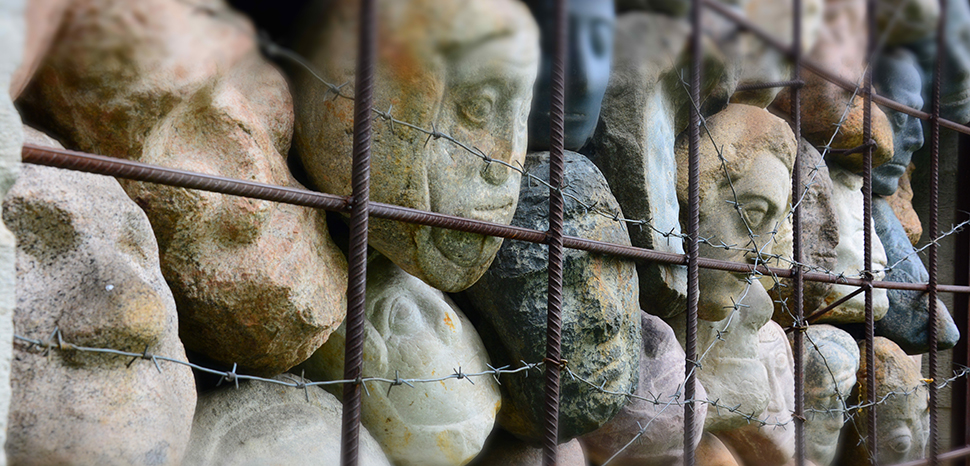“Sagalakov [chief of the Federal Penitentiary Service] gave us the green light for everything except corpses,” recounts Denis Golikov, one of the ex-kapos. This term is used officially in the modern prison camps in Russia, and designates the intra-camp police, or “developers.” They are recruited by the higher-ups and are endowed with administrative functions in relation to other convicts. Notably, they welcome the newcomers and mitigate differences of opinion inside the camp. The term “kapo” and its function in the modern Russian prison system relate directly to the concentration camps of the Third Reich and their kapos, which bore the same meaning.
However, it goes even further in post-Soviet countries. Denis Golikov, mentioned above, was one of the main kapos at the detention center N°1 in Irkutsk, a city known as “The Paris of Siberia.” 173 cm tall and weighing 56 kg in the first days of his sentence, Denis became, over time, the 117 kg “torture machine,” thanks to steroids that the prison administration secretly brought him and forced him to consume.
Making others suffer
Beating, tying up upside down, leaving in extreme cold, depriving of food, then refusing any medical assistance — these are the least cruel ways of torture that kapos would inflict upon other prisoners in Russia. Leaked videos from the body cam archives of the Russian Federal Penitentiary Service seem to prove that observation.
One of the projects to seek and obtain such videos is gulagu.net. Its YouTube channel counts, to this day, 1,416 videos and more than 469 hours of watch time. By selecting the subset of the first 250 videos ranked by popularity, with views ranging from six million to 85 thousand, some patterns start to emerge. Even though the subset makes up only 17.7% of the channel’s video archives (133 hours of watch time), this data is enough to underline the fact that non-psychological torture is a Russian favorite. The obtained statistics show this, and much more.
From 320 mentions of torture of any kind extracted from YouTube subtitles, 299 of them referred to physical harm. Apart from conventional fists and police batons, there were mentions of smoothing irons, hockey sticks, baseball bats, but also of more improvisational bricks in a boot, soap in a sock, or stuffing metal nails into one’s mouth. People with chronic diseases, like tuberculosis or epilepsy, would not be treated differently either. As a result, at least 6% of such beatings end up in death, and 5.4% suffer from broken arms, lost teeth, or damaged kidneys, liver, and genitalia.
Tying up and then leaving inmates alone for 2-3 days can be psychologically challenging as well. Around every tenth of Russian prisoners go through that. Positions can vary from seated to crucifixion and inversion (upside down). Some accounts from detention center N°6 in Kamchatka mention handcuffing a prisoner in the crucifixion position after opening his veins.
Torture by electricity becomes rare, with only 2% overall of mentions, no doubt because of fairly expensive equipment. The accounts of its utilization are notable nevertheless. One of them mentions 220V passed to genitalia, another one tying up the victim in bed sheets soaked in saline beforehand. The last one resulted in death.
The rarest torture methods, or the outliers in the gulagu.net subset, are forced defenestration, boiling water poured on the face, and drowning in a septic tank, all with one mention.
What is not rare in Russian prisons is rape. For decades now, a hierarchy is put in place in these establishments — there are officers, kapos, ordinary prisoners, and so-called “downcast,” or those who were raped, and whose status was “lowered.” In Irkutsk detention center N°1, they would live in the investigative committee department building N°3 and be divided by three ranks: higher-ups, dirty workers, and sex slaves.
This is, however, if they even survive the process of downcasting. In the gulagu.net subset were gathered mentions of group rape, penetration with a police baton, a broom, a soap, or rape performed by HIV/AIDS-positive inmates, as well as chili sauce poured inside the rectum and intentional spine breaking in the process. The most popular rape tools are the mop and immersion heater, with their 24.3% and 13.5% ratios. So much so that, in one case, the mop was pushed into rectum by 75 cm, damaging 7 of the victim’s vital organs and making him sterile; in another case, a defective immersion heater was shoved inside and then turned on, which resulted in an explosion and victim’s death.
As for psychological torment, 38% of such cases relate to tying up and then drugging with antipsychotic substances. This is the usual torture method for those who would survive beatings and rape to then mediatize their stories. One such victim was hanged in their vegetative state. In Irkutsk detention center N°1, all of this allegedly takes place in the psychiatric ward.
Consequences of political activism in Russia
All of the examples above are the mere tip of the iceberg, as they are restricted to what could have been extracted from the body cam archives, recounted by released prisoners, or known via the gulagu.net hotline.
Through that hotline, the following information was received at the beginning of July 2022: currently, at detention centers N°6 and N°7 in St. Petersburg, federal security officers are recruiting volunteers to Donbas among prisoners; they carry out motivational work and promise freedom for participation in operations to disable mines and restore buildings in the war-torn territories.
Some of the most known political activists are detained in the St. Petersburg penitentiary network. Alexandra Skochilenko, an anti-war advocate, and Ilya Pershin, a pro-Navalny protestor, are some of them.
In reality, political prisoners can be found at any Russian penitentiary establishment: Alexey Navalny is at detention center N°6 in the city of Vladimir, known as the “torture prison,” and Leonid Razvozzhayev, a left-wing oppositionist, was at detention center N°1 in Irkutsk, whose torture practices were mentioned plenty of times above.
Yet it must be underlined that in Russia physical and psychological torture go beyond penitentiary establishments. They can be used after arrest, and during the interrogation.
Going back to St. Petersburg, it is widely believed that methods of psychological torture were applied to activists arrested in protests at the end of February 2022. Notably, women were stripped naked and forced to squat. In the gulagu.net subset, squats performed naked represent 14.3% of psychological torture, even though, in that case, it was forced upon men, not women.
Furthermore, during the 2018 anarchist protests, Dmitry Tsibukovsky, a political activist in Chelyabinsk, described the electricity used to make him confess:
They brought in some kind of machine, they said that it was a taser of some sort, they strapped me to a chair and said that this was my last chance to write a confession. […] They didn’t let me sleep, eat, drink or use the toilet […] After I didn’t confess for a long time, one of the two officers who’d beaten me started tasering me. He tasered me more than five times in the leg, around my thigh. After each shock, he asked me if I’d made up my mind to speak. The pain from the electrocution was unbearable, and I decided to “confess,” give the evidence that the officers wanted, incriminate myself and others. For me, the main thing at that moment, in that situation, was to come out alive.
Legacy of the GULAG
This cruelty towards Russian political activists and prisoners goes beyond physical or psychological torture.
In the Soviet Union, medical experimentation on prisoners was recurrent, as reported by Vadim Birshtein, who studied GULAG’s archives on Grigory Mairanovsky, and Peter Deriabin, a KGB defectionist who once testified to the CIA that:
From 1946, the state security maintained at its Moscow headquarters a quietly notorious laboratory called the “chamber” (kamera). Its staff consisted of a medical director and several assistants, who performed experiments on living people – prisoners and persons about to be executed – to determine the effectiveness of various poisons and injections as well as the use of hypnotism and drugs in interrogation techniques.
Vasiliy Vlassov states a possible reason for Soviet disregard for prisoners’ lives in European Journal of Public Health:
The documents of the Nuremberg trials were not published in the USSR. […] In some Soviet “scientific” texts about the Nuremberg trials, the trial of Nazi doctors was not mentioned at all. Because documents of the trial were not published, the Nuremberg Code was not published till 1986. As a result of the isolationist policy of the Communist regime Soviet physicians were not informed about the emergence of the World Medical Association and the Helsinki Declaration which was developed from the Nuremberg Code. The regulation of human experimentation in Russia was and still is in a primitive state. […] Government documents are kept secret for an indefinite period of time, and even many documents that were declassified in the short period of Perestroika are now secret again. In December 2005, dozens of Chechen children from one school were hospitalized because of an unknown disease. After two weeks the disease was declared “mass psychosis” and information about the outbreak was classified.
The event Vlassov refers to at the end is the Shelkovsk incident, when around 100 children were simultaneously experiencing respiratory difficulties and roughly 1-hour muscle seizures. The official cause was, indeed, “mass psychosis”; the unofficial: some kind of toxic substance that makes the nervous system hypersensitive. What happened during treatment of the sick children has been kept secret; none of the patients was told what exactly was injected into them, and on discharge, the case notes were empty.
Beneath what is visible
Until 2021, Russian prisons were relatively well-known for their torture methods, not for their human experimentations. That changed on the morning of July 19th, 2021, when 47news published photos and videos allegedly from an underground secret prison disguised as an unfinished dacha, 40 kilometers from St. Petersburg. Its entrance was filled with concrete. When the journalists managed to get inside, they noticed that the bars, locks, and equipment were the same as in any other detention center in St. Petersburg. The only difference was the crematorium, whose dimensions corresponded to the size of an adult human body.
All these stories, data, and diagrams combine to create a pattern, one suggesting that Article 3 of the European Convention on Human Rights is far from respected in the Russian Federation, regardless of whether the individual in question is a criminal or a political activist.
Thus, the GULAG legacy lives on. Throughout the spirits of those who dare to speak out against evil, and those who are willing to submit to it.
Soviet propaganda also carries on. Torture, psychological torment, experimentations on the human body, and massive prison camps are what defined Nazis during the Second World War. Ironically, this is precisely what Russia accuses Ukraine of being right now.
The views expressed in this article belong to the authors alone and do not necessarily reflect those of Geopoliticalmonitor.com




